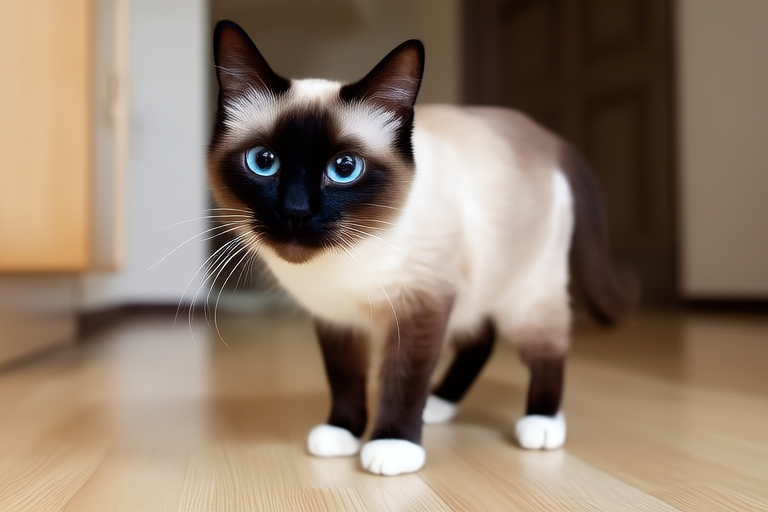The Siamese Cat: A Guide to Owning One of the Most Chatty Companions
Welcome to the world of the Siamese cat, a breed renowned for its striking appearance and unique personality. With their sleek, short-haired coats and expressive blue almond-shaped eyes, Siamese cats are unmistakable. But it’s their vocal nature that truly sets them apart. If you’re considering adding a Siamese to your family or are already enjoying the company of one, this guide will help you understand and appreciate these fascinating creatures.
Introduction: Distinctive Appearance and Vocal Nature
Siamese cats have a lean, muscular body structure with a wedge-shaped head that adds to their elegant appearance. Their coats come in various shades of seal point, blue point, chocolate point, and lilac point, with darker coloration around the face, ears, paws, and tail, known as “points.” This striking contrast against their lighter bodies makes them stand out. However, what many find most endearing about Siamese cats is their talkative demeanor. They are known to be highly communicative, often engaging their owners in conversation through a range of meows, chirps, and even purrs. Their vocalizations can vary from soft coos to loud, insistent cries, making them an active presence in any household.
A Brief History of the Siamese Breed
The origins of the Siamese cat trace back to Thailand, formerly known as Siam, where they were revered by royalty and kept in temples. The breed was first introduced to the Western world in the late 19th century when they were brought to Britain and then to the United States. Over time, selective breeding has refined the Siamese’s physical attributes and accentuated their vocal tendencies. Today, the Siamese remains one of the most popular and recognizable breeds globally, admired for their beauty and engaging personalities.
Ideal Living Conditions for Siamese Cats
Siamese cats thrive in environments that cater to their social and interactive nature. While they adapt well to different living spaces, they particularly enjoy homes with plenty of room to explore and play. Providing climbing structures, scratching posts, and interactive toys can keep them mentally stimulated and physically active. Additionally, because of their vocal nature, they may not be suited for households where quiet is preferred. Ensuring they have a comfortable, warm space to rest is also essential, as Siamese cats tend to prefer warmer temperatures.
Dietary Needs of Siamese Cats
Feeding a Siamese cat a balanced diet is crucial for maintaining their health and vitality. High-quality commercial cat food that meets their nutritional needs is generally sufficient. Look for products rich in protein, vitamins, and minerals. It’s important to avoid overfeeding, as Siamese cats can become overweight if given too much food. Consult your veterinarian to determine the appropriate amount of food based on your cat’s age, weight, and activity level. Fresh water should always be available to ensure proper hydration.
Common Health Issues in Siamese Cats
Like all breeds, Siamese cats are prone to certain health issues. Genetic factors contribute to some conditions more than others. For example, they may be susceptible to dental problems, respiratory issues, and heart diseases. Regular veterinary check-ups are vital to catch and address any potential health concerns early. Maintaining a healthy weight and providing proper nutrition can help reduce the risk of many ailments. Early intervention and proactive care can significantly improve the quality of life for your Siamese cat.
Grooming Requirements for Siamese Cats
Despite their short coats, Siamese cats require regular grooming to maintain their coat’s health and appearance. Weekly brushing helps remove loose hair and prevents matting. Bathing should be done sparingly, only when necessary, to avoid stripping natural oils from their skin. Pay attention to their nails; regular trimming is essential to prevent overgrowth, which can cause discomfort or lead to injuries. Cleaning their ears and checking for any signs of infection is also part of good grooming practices. Overall, grooming sessions offer an opportunity for bonding and reinforcing positive interactions between you and your cat.
Behavioral Traits of Siamese Cats
Siamese cats are known for their strong attachment to their human companions. They form close bonds and can be quite affectionate, often following their owners around the house. Their intelligence makes them quick learners, and they can be trained to perform tricks or respond to commands. However, this same intelligence can sometimes lead to mischief if they become bored or under-stimulated. Providing mental stimulation through puzzle toys, training sessions, and interactive games can help channel their energy positively. Socialization is key, especially for Siamese cats, as they enjoy interacting with people and other animals. Early exposure to different environments and experiences can foster a well-rounded, confident cat.
Tips for Potential Owners
If you’re considering adopting a Siamese cat, there are several things to keep in mind. First, be prepared for a lot of interaction. These cats demand attention and can become distressed if left alone for long periods. Consider the layout of your home and whether it provides ample space for your cat to move freely and safely. Investing in sturdy furniture and childproofing measures can protect both your belongings and your cat. Research local shelters and rescue organizations to find a reputable source for adoption. Lastly, ensure you have a trusted veterinarian who understands the specific needs of Siamese cats.
Integrating a Siamese Cat into Your Family
Bringing a Siamese cat into your family can be a rewarding experience, especially when you understand their sociable and intelligent nature. Children can benefit greatly from learning responsibility through caring for a pet, but it’s important to supervise interactions to ensure safety. Introducing a new Siamese cat to existing pets requires patience and gradual acclimation. Use treats and positive reinforcement to encourage peaceful coexistence. Establishing routines for feeding, playtime, and grooming helps create a stable environment that promotes security and happiness for your Siamese cat. By embracing their need for companionship and mental engagement, you’ll build a strong bond with your Siamese cat that enriches both lives.
